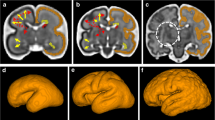Abstract
We describe the MRI appearances of an anencephalic newborn who survived for 13 h; particularities of this case are male gender and the absence of other associated malformations. Moreover, we discuss the pathogenetic theories of anencephaly, correlating MRI findings with embryological data. An exencephaly–anencephaly sequence due to amnion rupture is hypothesized.



Similar content being viewed by others
References
Naidich TP, Altman NR, Braffman BH, et al (1992) Cephaloceles and related malformations. AJNR 13:655–690
2. Tortori-Donati P, Fondelli MP, Rossi A (1996) Anencefalia. In: Tortori-Donati P, Taccone A, Longo M (eds) Malformazioni cranio-encefaliche. Edizioni Minerva Medica, Torino, pp 152–155
Brook FA, Estibeiro JP, Copp AJ (1994) Female predisposition to cranial neural tube defects is not because of a difference between the sexes in the rate of embryonic growth or development during neurulation. J Med Genet 31:383–387
Lewis DP, Van Dyke DC, Stumbo PJ, et al (1998) Drug and environmental factors associated with adverse pregnancy outcomes. Part I: antiepileptic drugs, contraceptives, smoking, and folate. Ann Pharmacother 32:802–817
Winsor SH, McGrath MJ, Khalifa M, et al (1997) A report of recurrent anencephaly with trisomy 2p23-2pter: additional evidence for the involvement of 2p24 in neural tube development and evaluation of the role for cytogenetic analysis. Prenat Diagn 17:665–669
Arnold WH, Lang M, Sperber GH (2001) 3D-reconstruction of craniofacial structures of a human anencephalic fetus. Case report. Ann Anat 183:67–71
Volpe JJ (2001) Neurology of the newborn. Saunders, Philadelphia
Calzolari E, Bianchi F, Dolk H, et al (1997) Are omphalocele and neural tube defects related congenital anomalies? Data from 21 registries in Europe (EUROCAT). Am J Med Genet 72:79–84
Kashani AH, Hutchins GM (2001) Meningeal-cutaneous relationships in anencephaly: evidence for a primary mesenchymal abnormality. Hum Pathol 32:553–558
Matsumoto A, Hatta T, Moriyama K, et al (2002) Sequential observations of exencephaly and subsequent morphological changes by mouse exo utero development system: analysis of the mechanism of transformation from exencephaly to anencephaly. Anat Embryol (Berl) 205:7–18
Cox GG, Rosenthal SJ, Holsapple JW (1985) Exencephaly: sonographic findings and radiologic-pathologic correlation. Radiology 155:755–756
Yaron H, Hamby DD, O’Brien JE, et al (1998) Combination of elevated maternal serum alpha-fetoprotein (MSAFP) and low estriol is highly predictive of anencephaly. Am J Med Genet 75:297–299
Aguiar MJ, Campos AS, Aguiar RA, et al (2003) Neural tube defects and associated factors in liveborn and stillborn infants. J Pediatr 79:129–134
Wang Y, Zhu J, Wu Y (1998) Dynamic variation of incidence of neural tube defects during 1988 to 1992 in China (in Chinese). Zhonghua Yu Fang Yi Xue Za Zhi 32:369–371
Johnson SP, Sebire NJ, Snijders RJ, et al (1997) Ultrasound screening for anencephaly at 10-14 weeks of gestation. Ultrasound Obstet Gynecol 9:14–16
Weissman A, Diukman R, Auslender R (1997) Fetal acrania: five new cases and review of the literature. J Clin Ultrasound 25:511–514
Ippel PF, Breslau-Siderius EJ, Hack WW, et al (1998) Atelencephalic microcephaly: a case report and review of the literature. Eur J Pediatr 157:493–497
Poe LB, Coleman L (1989) MR of hydranencephaly. AJNR 10:S61
Hoving EW (2000) Nasal encephaloceles. Childs Nerv Syst 16:702–706
Urioste M, Rosa A (1998) Anencephaly and faciocranioschisis: evidence of complete failure of closure 3 of the neural tube in humans. Am J Med Genet 75:4–6
Keeling JW, Kjaer I (1994) Diagnostic distinction between anencephaly and amnion rupture sequence based on skeletal analysis. J Med Genet 31:823–829
Kjaer I, Keeling JW, Graem N (1994) Cranial base and vertebral column in human anencephalic fetuses. J Craniofac Genet Dev Biol 14:235–244
Timor-Tritsch IE, Greenebaum E, Monteagudo A, et al (1996) Exencephaly-anencephaly sequence: proof by ultrasound imaging and amniotic fluid cytology. J Matern Fetal Med 5:182–185
Ferris NJ, Tien RD (1994) Amnion rupture sequence with ’exencephaly’: MR findings in a surviving infant. AJNR 15:1030–1033
Moore KL, Persaud TV (1993) The developing human. Saunders, Philadelphia
Bernardo AI, Kirsch LS, Brownstein S (1991) Ocular anomalies in anencephaly: a clinicopathological study of 11 globes. Can J Ophthalmol 26:257–263
O’Rahilly R, Muller F (1989) Bidirectional closure of the rostral neuropore in the human embryo. Am J Anat 184:259–268
Sennaroglu L, Saatci I (2002) A new classification for cochleovestibular malformations. Laryngoscope 112:2230–2241
Pilavdzic D, Kovacs K, Asa SL (1997) Pituitary morphology in anencephalic fetuses. Neuroendocrinology 65:164–172
Walters J, Ahwal S, Masek T (1997) Anencephaly: where do we now stand? Semin Neurol 17:249–255
Levine D, Barnes PD, Robertson RR, et al (2003) Fast MR imaging of fetal central nervous system abnormalities. Radiology 229:51–61
Author information
Authors and Affiliations
Corresponding author
Rights and permissions
About this article
Cite this article
Calzolari, F., Gambi, B., Garani, G. et al. Anencephaly: MRI findings and pathogenetic theories. Pediatr Radiol 34, 1012–1016 (2004). https://doi.org/10.1007/s00247-004-1259-8
Received:
Revised:
Accepted:
Published:
Issue Date:
DOI: https://doi.org/10.1007/s00247-004-1259-8




